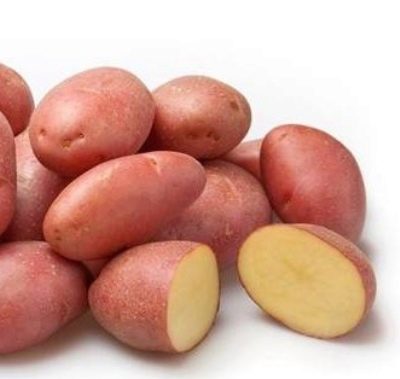
- Authors: Zueva O. I., Bryantseva E. V., Slobodina G. N., Zuev V. E., Kolesova T. A. (JSC "Vsevolozhskaya breeding station")
- Year of approval: 2007
- Appointment: table, suitable for making French fries, chips
- Tuber weight, g: 91-133
- Peel color: red
- Color of the pulp: cream
- Starch content,%: 11,9-15,0%
- Tuber shape: oval
- Peel structure: smooth
- Eyes: small
Ryabinushka potatoes are a variety that demonstrates excellent taste and attracts gardeners with high yields. It is worth taking a closer look at the characteristics of the potato and the crop cultivation scheme.
Breeding history
The Ryabinushka variety was bred by domestic breeders. The potato was obtained relatively recently; the variety was entered into the State Register only in 2007. Over the past 10 years, Ryabinushka has quickly spread across most regions of Russia and has become in demand among gardeners.
Description of the variety
Among the main characteristics of the variety are:
bushes - erect;
stems are powerful;
leaf plates are mostly medium in size, wavy and dark green;
flowers - violet-blue hue.
Characteristics of the appearance of the bush and root crops
Ryabinushka potato bushes are small in height and compact in size. Characteristics of the fruits of the variety:
the skin is smooth, red, of small thickness;
shape - oval;
eyes are small;
the pulp is creamy.
The average weight of one tuber ranges from 91 to 133 g.
Purpose and taste of tubers
The average starch content in Ryabinushka potatoes is 11.9-15%. The tubers are also rich in anthocyanins, as evidenced by the red color of the skin, and the shade of the pulp indicates a high beta-carotene content.
The culinary use of potatoes is universal, the fruits are used to make soups, salads, and second courses. During cooking, tubers perfectly retain their shape and give out an appetizing aroma, taste is rated at the highest point.
Maturation
On average, Ryabinushka potatoes ripen 80-90 days from the moment of planting.
Yield
Gardeners value potatoes for their high yields. One hectare of land is capable of producing up to 400 centners of large root crops. One bush forms up to 18 tubers per season.
Growing and caring
You can achieve the necessary yield indicators by carefully studying the characteristics of planting and growing this variety. First of all, it is worth preparing the tubers for planting. Gardeners begin this procedure in early or mid-May. Main steps.
Selection of root crops and elimination of small or damaged samples.
Keeping tubers in a dry and warm place for 2-3 weeks until the first shoots up to 1.5 cm long appear.
Disinfection of root crops with a solution of boric acid, where the fruits are placed for 20-30 minutes before planting.
Planting prepared tubers is carried out according to the following scheme.
The distance between the rows is 70-80 cm.
The distance between tubers is 30-35 cm.
The depth of the hole is 4-5 cm for clay soils, and 10-12 cm for sand or sandy loam.
The next point that must be taken into account is caring for the plant. It should include a number of activities.
Watering. The variety is picky about watering, so during the season it is necessary to carry out the procedure at least 3-4 times. If potatoes are grown in hot regions, then watering should be increased up to 4-5 times per season.The first time the bushes are watered after planting, then after the emergence of the potatoes, during the flowering of the tops and at the end of the formation of buds by the bush.
Top dressing. When planting potatoes in fertile soil, you can forget about additional fertilizers. If the land cannot boast of a sufficient amount of nutrients, it is recommended to fertilize it 1-2 times per season with organic compounds in the form of a mixture of ash or humus.
Hilling and weeding. Essential procedures that ensure the flow of oxygen and nutrients to the roots, as well as prevent the appearance of diseases and pests. Potatoes are huddled and weeded at the same time about 1-2 times per season.
After harvesting, the finished tubers should be dried so that they do not start to rot in the underground.

Planting potatoes is one of the main spring activities traditional for Russian gardeners. There are many ways to plant this vegetable, allowing you to get a good harvest in different conditions and climates. Before planting, you need to carefully prepare the planting material, correctly determine the timing, competently prepare the soil.


Soil requirements
When choosing a place for planting Ryabinushka potatoes, preference should be given to fertile and sunny areas where there are no drafts. Excellent predecessors for the variety will be:
peas;
beans;
cabbage;
cucumbers;
cereals.
Before planting, it is worth loosening the soil and applying organic fertilizers. It is better to do this in autumn and spring to increase the fertility of the soil and reduce its acidity.

Disease and pest resistance
The mountain ash is distinguished by strong immunities and is not exposed to popular diseases and the attack of known pests. However, gardeners recommend carrying out preventive treatments of the variety, with the help of which it is possible to increase resistance to late blight and fungus, as well as prevent the appearance of the Colorado potato beetle on the bushes.

Potatoes are a popular vegetable crop that many gardeners planted on their site. But growing a bountiful harvest of tasty and large tubers is unlikely to succeed if the beds are not properly protected from the most common diseases and pests. Often, the development of diseases of various etiologies of potatoes goes unnoticed, so it is important to identify the problem in time and eliminate it.
















































































